Product Management Basics: What Every PM Needs to Know
If you're new to product management, this article is a must-read.
Posted June 13, 2025

Table of Contents
Free Event

Featuring Christina P.
AMA: Ask Me Anything About Being a PM at a Startup
Starting Wednesday, September 17
4:00 PM UTC · 30 minutes

Featuring Christina P.
If you're a product manager or are aspiring to become one, understanding the basics of product management is crucial for your success. In this article, we will cover everything you need to know about product management, from defining the role to launching and scaling a product. Let's dive in.
Defining Product Management: A Comprehensive Overview
Product management is a vital component of any business that aims to create and sell products or services. A product manager (PM) is responsible for the strategy, development, and launch of a product or service. They are the glue that brings together all the teams involved in the product development cycle, from marketing and sales to engineering and design.
One of the key responsibilities of a product manager is to conduct market research and analyze customer feedback to identify opportunities for new products or improvements to existing ones. They work closely with the engineering and design teams to ensure that the product meets the needs of the target market and is delivered on time and within budget.
Product management also involves managing the product throughout its lifecycle, from ideation to retirement. This includes making decisions about pricing, distribution channels, and marketing strategies. A successful product manager must be able to balance the needs of the customer with the goals of the business, while also keeping an eye on the competition and industry trends.
The Importance of Product Management for Business Growth
The success of a business largely depends on its ability to create and deliver products that meet the needs and wants of its target customers. Product management plays a crucial role in identifying and developing products that can help a business grow and thrive.
Effective product management involves a deep understanding of the market, competition, and customer needs. It requires a combination of analytical skills, creativity, and strategic thinking to develop products that are not only innovative but also profitable. Product managers must work closely with cross-functional teams, including engineering, design, marketing, and sales, to ensure that the product is developed and launched successfully.
Furthermore, product management is not a one-time activity but an ongoing process. It involves continuous monitoring of the market, customer feedback, and product performance to identify opportunities for improvement and innovation. By investing in product management, businesses can stay ahead of the competition, increase customer satisfaction, and drive revenue growth.
Role of a Product Manager: Responsibilities and Key Skills
The role of a product manager involves numerous responsibilities, including conducting market research, developing a strategic roadmap, prioritizing features, and working with cross-functional teams. A product manager should possess excellent communication, leadership, problem-solving, and analytical skills.
Additionally, a product manager must also have a deep understanding of the target market and customer needs. This involves conducting user research, analyzing customer feedback, and staying up-to-date with industry trends. A product manager must also be able to make data-driven decisions and be comfortable with ambiguity and uncertainty. They must be able to adapt quickly to changing market conditions and adjust their product strategy accordingly.
Understanding the Product Life Cycle: From Concept to Launch
The product life cycle (PLC) is a process that outlines the stages a product goes through from ideation to retirement. The stages are product development, introduction, growth, maturity, and decline. A product manager should have a good understanding of the PLC to ensure that the product is developed and launched in a timely and efficient manner.
The first stage of the PLC is product development, where the product idea is conceptualized and developed. This stage involves market research, product design, and testing to ensure that the product meets the needs of the target audience. Once the product is developed, it moves to the introduction stage, where it is launched into the market.
The growth stage is the next phase, where the product gains traction in the market and sales start to increase. This is a critical stage for the product, as it is important to maintain the momentum and continue to innovate to stay ahead of competitors. The maturity stage follows, where sales growth slows down, and the product reaches its peak. At this stage, it is important to focus on maintaining market share and profitability.
Conducting Market Research: Gathering Insights for Product Development
Market research is a critical component of the product development process. A product manager should conduct thorough market research to identify customer pain points, analyze the competition, and gather insights that can help in developing a product that meets the user's needs.
One of the key benefits of conducting market research is that it helps in identifying new opportunities for product development. By analyzing the market trends and customer behavior, a product manager can identify gaps in the market that can be filled with a new product. This can help in creating a competitive advantage and increasing the chances of success for the product.
Developing a Strategic Roadmap: Aligning Business Goals with Product Vision
A strategic roadmap is a high-level plan that outlines the goals and objectives of a business and how a product can help in achieving those goals. A product manager should develop a strategic roadmap that aligns with the business's vision and mission.
When developing a strategic roadmap, it is important to consider the market trends and competition. Conducting market research and analyzing the competition can help a product manager identify opportunities and potential threats. This information can then be used to create a roadmap that not only aligns with the business's goals but also takes into account the external factors that may impact the success of the product.
Identifying Target Customers and Creating User Personas for Better Understanding
Identifying the target customer is a crucial step in the product development process. A product manager should create user personas to gain a deeper understanding of their target audience and their needs, preferences, behaviors, and buying patterns.
One of the benefits of creating user personas is that it helps product managers to identify potential pain points that their target customers may face. By understanding these pain points, product managers can develop solutions that address these issues and provide a better user experience.
Another advantage of creating user personas is that it helps product managers to prioritize features and functionalities based on the needs of their target customers. This ensures that the product is designed to meet the most important needs of the target audience, which can increase the chances of success in the market.
Prioritizing Features and Creating a Product Roadmap
After conducting market research and identifying the target customer, a product manager should prioritize the features that will deliver the most value to the user. Creating a product roadmap that outlines the launch timeline and feature delivery schedule is also essential.
Working with Cross-functional Teams: Collaboration and Communication Skills
Product management is a collaborative effort that involves working with cross-functional teams such as marketing, engineering, and design. A product manager should have excellent collaboration and communication skills to ensure that all teams are working towards a common goal and that everyone is on the same page.
Building Prototypes and Minimum Viable Products (MVPs) for Testing
Building prototypes and minimum viable products (MVPs) is a crucial step in the product development process. An MVP is a simple version of a product that is developed and launched to test its viability in the market. A product manager should work with the engineering and design teams to build prototypes and MVPs that can be tested and refined based on customer feedback.
Launching the Product: Key Considerations and Best Practices
Launching a product is a crucial step in the product development cycle. A product manager should have a launch strategy that takes into account factors such as timing, pricing, marketing, and distribution channels.
Post-Launch Activities: Monitoring Performance Metrics and Collecting Customer Feedback
Monitoring post-launch performance metrics such as sales, revenue, and customer satisfaction is critical to determining the product's success. Collecting customer feedback is also important to identify areas where the product can be improved and to make data-driven decisions on future product development.
Measuring Success: KPIs for Evaluating Product Performance
A product manager should define and track key performance indicators (KPIs) that will measure the product's success. KPIs such as customer acquisition costs, lifetime value, and retention rate can provide insight into the product's performance and can aid in decision-making for future product development.
Staying Ahead of the Competition: Continuous Improvement and Iteration
Competition is fierce in today's market, and a product manager should ensure that their product is continuously improving and evolving to meet customer needs and outpace the competition. Iterating on the product based on customer feedback and market insights is crucial.
Scaling the Product: Strategies for Growth and Expansion
After successfully launching a product, a product manager should devise strategies for growth and expansion. This can include expanding into new markets, developing new products, and scaling the current product to meet increasing demand.
Common Challenges faced by PMs and How to Overcome Them
Product management is not without its challenges. Lack of resources, changing market conditions, and a misaligned vision can all pose difficulties for a product manager. However, by staying adaptable, building strong relationships with cross-functional teams, and focusing on the user's needs, a product manager can overcome these challenges.
In conclusion, product management is a complex but rewarding role that requires a diverse set of skills and an in-depth understanding of the product development cycle. By following the best practices outlined in this article and staying customer-focused, a product manager can successfully develop, launch, and grow products that meet the needs and wants of their target audience, leading to business success.











